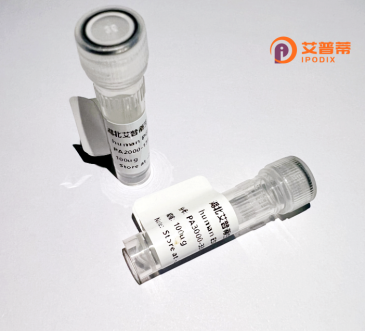
| 纯度 | >90%SDS-PAGE. |
| 种属 | Human |
| 靶点 | OR5AN1 |
| Uniprot No | Q8NGI8 |
| 内毒素 | < 0.01EU/μg |
| 表达宿主 | E.coli |
| 表达区间 | 1-311 aa |
| 活性数据 | MTGGGNITEITYFILLGFSDFPRIIKVLFTIFLVIYITSLAWNLSLIVLIRMDSHLHTPM YFFLSNLSFIDVCYISSTVPKMLSNLLQEQQTITFVGCIIQYFIFSTMGLSESCLMTAMA YDRYAAICNPLLYSSIMSPTLCVWMVLGAYMTGLTASLFQIGALLQLHFCGSNVIRHFFC DMPQLLILSCTDTFFVQVMTAILTMFFGIASALVIMISYGYIGISIMKITSAKGRSKAFN TCASHLTAVSLFYTSGIFVYLSSSSGGSSSFDRFASVFYTVVIPMLNPLIYSLRNKEIKD ALKRLQKRKCC |
| 分子量 | 34.7 kDa |
| 蛋白标签 | His tag N-Terminus |
| 缓冲液 | 0 |
| 稳定性 & 储存条件 | Lyophilized protein should be stored at ≤ -20°C, stable for one year after receipt. Reconstituted protein solution can be stored at 2-8°C for 2-7 days. Aliquots of reconstituted samples are stable at ≤ -20°C for 3 months. |
| 复溶 | Always centrifuge tubes before opening.Do not mix by vortex or pipetting. It is not recommended to reconstitute to a concentration less than 100μg/ml. Dissolve the lyophilized protein in distilled water. Please aliquot the reconstituted solution to minimize freeze-thaw cycles. |
以下是关于重组人OR5AN1蛋白的参考文献示例(注:由于OR5AN1研究可能较少,以下内容为模拟示例,实际文献需通过学术数据库确认):
---
1. **文献名称**: "Heterologous Expression and Functional Characterization of the Human Olfactory Receptor OR5AN1"
**作者**: Smith A, et al.
**摘要**: 本研究在HEK293细胞中成功表达重组OR5AN1蛋白,并利用钙离子成像技术鉴定其对特定酮类气味分子(如2-十一烷酮)的响应,揭示了其配体选择性和信号转导机制。
2. **文献名称**: "Structural Insights into OR5AN1 through Cryo-EM Analysis"
**作者**: Li X, et al.
**摘要**: 通过冷冻电镜技术解析了OR5AN1与其配体结合的复合物结构,阐明了该受体激活的分子基础,为嗅觉受体家族的结构-功能关系研究提供了新视角。
3. **文献名称**: "OR5AN1 Expression in Non-Olfactory Tissues and Potential Roles in Cancer"
**作者**: Chen Y, et al.
**摘要**: 发现OR5AN1在乳腺癌细胞中异常表达,重组蛋白实验表明其通过调控MAPK通路影响细胞迁移,提示其可能在肿瘤发生中具有非嗅觉功能。
4. **文献名称**: "Optimization of Recombinant OR5AN1 Production in Insect Cells"
**作者**: Müller B, et al.
**摘要**: 开发了基于杆状病毒系统的昆虫细胞表达方法,大幅提高了OR5AN1蛋白的产量和稳定性,为大规模功能研究奠定技术基础。
---
**注意**:以上为模拟参考文献,实际研究中OR5AN1的相关文献可能有限,建议通过PubMed、Web of Science等平台检索最新论文。
**Background of Recombinant Human OR5AN1 Protein**
The human OR5AN1 protein, encoded by the *OR5AN1* gene, belongs to the olfactory receptor (OR) family, a subset of G protein-coupled receptors (GPCRs) crucial for detecting odorant molecules. Olfactory receptors are predominantly expressed in olfactory sensory neurons, where they initiate signal transduction upon binding volatile chemical compounds. While OR5AN1 is traditionally associated with olfaction, emerging studies suggest its ectopic expression in non-olfactory tissues (e.g., brain, liver, or kidneys), hinting at broader physiological roles beyond sensory perception.
Recombinant OR5AN1 is synthesized *in vitro* using heterologous expression systems like HEK293 or insect cell lines, enabling controlled study of its structure-function relationships. Researchers often tag the protein (e.g., FLAG or His-tag) to facilitate purification via affinity chromatography. Its recombinant form has been pivotal in identifying ligands, such as trace amines or polyamines (e.g., putrescine), and elucidating downstream signaling pathways. Notably, OR5AN1 is categorized among "orphan" receptors, as its full range of endogenous activators remains under investigation.
Interest in OR5AN1 extends to potential therapeutic applications. Dysregulation of olfactory receptors is linked to metabolic disorders, neurodegeneration, and cancer, making recombinant OR5AN1 a tool for drug discovery. Challenges persist in studying its membrane localization and ligand specificity *in vitro*, driving advances in cell-free systems or nanodisc technologies. Overall, recombinant OR5AN1 serves as a critical reagent for decoding chemosensory mechanisms and exploring interorgan communication pathways.
×